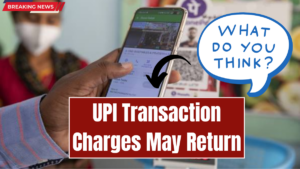UPI has been the backbone of India’s digital payments landscape for years—efficient, real-time, and most importantly, free for users and merchants. From local vendors to large-scale businesses, everyone benefited from zero-fee transactions. However, this frictionless model may soon change.
The Payments Council of India (PCI) has recommended bringing back MDR (Merchant Discount Rate) charges for UPI and RuPay transactions to ensure long-term financial viability. This has sparked discussions across industries, as businesses, banks, and consumers consider the broader impact of such a move.

Why Are UPI Transaction Charges Being Reconsidered?
Initially, UPI transactions involved a small fee, which was later waived in 2020 by the government to promote cashless payments. Since then, service providers have relied on government subsidies to keep the system running. But with subsidies reduced in FY25, stakeholders argue that reintroducing MDR is necessary to maintain and upgrade infrastructure.
Proposed Change Overview:
-
A suggested MDR of up to 0.3% on large merchant UPI transactions
-
Affects RuPay transactions as well
-
Consumers won’t be directly charged
-
Designed to ease financial pressure on payment platforms
How UPI Became Free—And Why That Could End Soon
Before 2020, UPI merchants paid MDR, usually under 1% per transaction. This revenue supported payment gateways, banks, and app developers. The government’s 2020 move to eliminate MDR came with a ₹3,500 crore subsidy. However, in 2025, that amount has been cut to ₹1,500 crore, despite estimates suggesting the system requires over ₹10,000 crore annually.
This widening gap has prompted calls for a sustainable model that doesn’t overburden public funding.
What Is MDR and Why Does It Matter?
MDR (Merchant Discount Rate) is the fee that merchants pay to banks and payment service providers for enabling digital transactions. The money collected goes toward maintaining the technology, cybersecurity, fraud prevention, and user support.
Comparison of MDR Rates by Payment Method:
-
Credit Cards: 1% – 3%
-
Debit Cards: 0.5% – 1%
-
UPI Transactions (current): 0%
-
RuPay Debit Cards (current): 0%
With UPI usage skyrocketing, many believe MDR is essential to keep the ecosystem functioning efficiently and securely.
Why the Industry Wants MDR Charges on UPI Again
The payments industry is advocating for MDR charges on UPI for several key reasons:
-
Reduced Subsidies: Government support is falling short of operational costs
-
High Infrastructure Demands: UPI requires heavy investment in secure and scalable systems
-
No Profit on UPI Payments: Unlike credit or debit cards, UPI generates no revenue for service providers
-
Creating Fair Competition: Introducing MDR creates parity across all digital payment modes
How Reintroducing MDR Could Affect Stakeholders
If MDR returns, the ripple effects will be felt by all parts of the digital payment chain.
For Merchants:
-
Higher operating costs for each UPI transaction
-
Possibility of passing fees to customers
-
Increased preference for cash or card payments
For Consumers:
-
No direct UPI charges, but indirect price hikes possible
-
Potential decrease in UPI acceptance by small vendors
-
Rise in cash incentives or discounts
For Payment Providers:
-
A new revenue stream to maintain backend systems
-
Scope to improve security, app quality, and transaction speeds
-
Stronger financial model for future innovation
Key Factors Behind the Push for MDR
-
Lower government funding for UPI operations
-
Escalating tech and maintenance costs
-
No earnings from UPI compared to other methods
-
Leveling the financial playing field for payment platforms
FAQs
Will consumers be charged directly for using UPI?
No. Consumers will not be directly billed. However, merchants might include the cost in product pricing.
Why were UPI transaction charges removed earlier?
The government removed MDR in 2020 to encourage digital payments and help small businesses adapt to cashless methods.
How much MDR is being proposed now?
A suggested MDR of up to 0.3% is under discussion, mainly targeting large businesses that already pay MDR on cards.
Will MDR slow down digital payments?
There is a possibility. Merchants may return to cash-based transactions if digital payments become expensive for them.
When will we know the final decision?
The proposal is still under government review. An official decision is expected soon based on its economic impact.
Final Thought
The reintroduction of UPI transaction charges could reshape India’s digital payment habits. While MDR could make the system more financially viable for service providers, it also risks alienating small merchants and everyday users.
India now stands at a pivotal point—balancing innovation with accessibility. Whether MDR comes back or not, the evolution of UPI will define how we pay, save, and spend in the coming years.
Click here to know more.
Aanchal is a passionate writer with a keen interest in storytelling, content creation, and creative expression. She enjoys exploring diverse topics and crafting engaging narratives that captivate readers.

